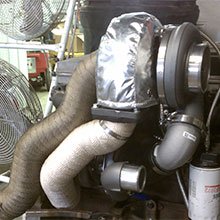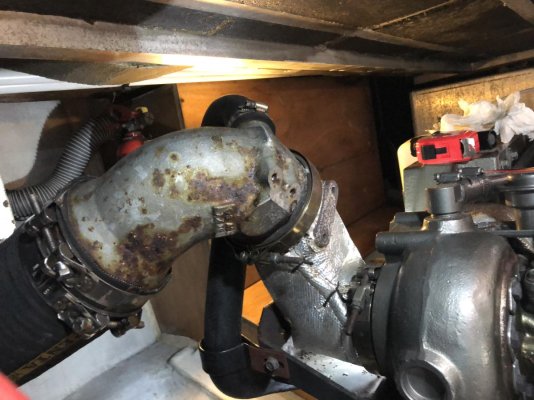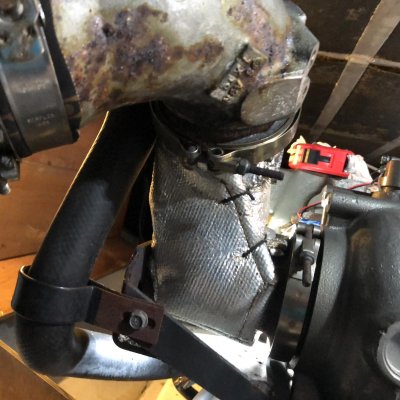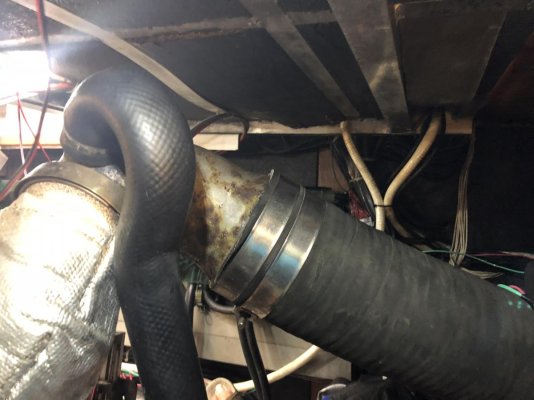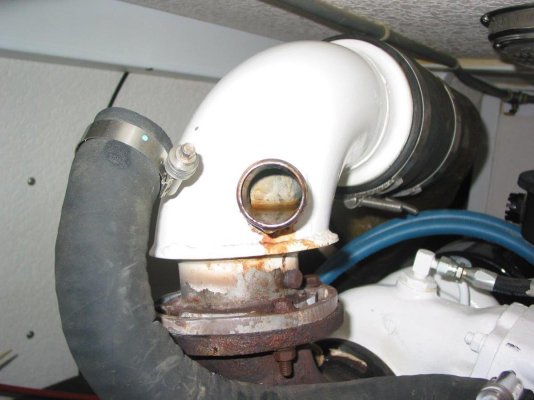You are using an out of date browser. It may not display this or other websites correctly.
You should upgrade or use an alternative browser.
You should upgrade or use an alternative browser.
Exhaust wrap
- Thread starter lipets
- Start date
The friendliest place on the web for anyone who enjoys boating.
If you have answers, please help by responding to the unanswered posts.
If you have answers, please help by responding to the unanswered posts.
Northern Spy
Guru
- Joined
- Feb 5, 2012
- Messages
- 4,075
- Location
- Canada
- Vessel Name
- Northern Spy
- Vessel Make
- Nordic Tug 26
I just asked an insulator (yes, it is an actual trade). He said that would be a really bad idea, if the blanket is wrapped. Put the wrap under the blanket.
exhaust has the blankets but don't fit 100%,
thinking about adding wrap in fact I have extra any harm putting a layer on top of the blankets?
any other parts worth wrapping?
caltexflanc
Guru
Turbos if you have them. Best way to determine is take a temp gun to the engines after they've been run for awhile and see which parts you want to insulate. Best to consult the engine manufacturer or experts like D' Angelo or MESA.
Turbos are usually coolant jacketed so don't need wrap. I am not sure why the PP didn't like wrap over fitted blankets. I suspect that if his existing blankets don't fit well, they will be worse with a layer of insulation wrap under them.
But why do you want to add insulation. Is the engine room too hot. Are there hot spots in the insulation that could cause a fire hazard. Usually if you have 95+% of the exhaust covered with insulation before the mixer you will be ok.
David
But why do you want to add insulation. Is the engine room too hot. Are there hot spots in the insulation that could cause a fire hazard. Usually if you have 95+% of the exhaust covered with insulation before the mixer you will be ok.
David
Last edited:
caltexflanc
Guru
Turbos are usually coolant jacketed so don't need wrap.
The operative word there is "usually". That's why I advise talking to the engine manufacturer or a marine exhaust company. Engines on my boat were an exception to "usually".
Northern Spy
Guru
- Joined
- Feb 5, 2012
- Messages
- 4,075
- Location
- Canada
- Vessel Name
- Northern Spy
- Vessel Make
- Nordic Tug 26
The turbine housing of my turbo charger is blanketed, but the compressor housing is not. This is generally done to keep the charge air cool, but on a boat I suspect it is actually for personal protection, as engines are not hidden under a hood, to prevent accidental burns, and limit engine makers liability. Hence the loose fitting blanket.
I think the insulators concern is that blankets are made of friable insulating material, fibreglass or mineral wool, and therefore are contained in a fabric or metallic wrap. Wrapping over the blanket would trap heat in, which may overheat the fabric blanket material and cause it to prematurely deteriorate.
I think the insulators concern is that blankets are made of friable insulating material, fibreglass or mineral wool, and therefore are contained in a fabric or metallic wrap. Wrapping over the blanket would trap heat in, which may overheat the fabric blanket material and cause it to prematurely deteriorate.
lipets
Senior Member
No not too hot just saw it was not 100% where the blankets areTurbos are usually coolant jacketed so don't need wrap. I am not sure why the PP didn't like wrap over fitted blankets. I suspect that if his existing blankets don't fit well, they will be worse with a layer of insulation wrap under them.
But why do you want to add insulation. Is the engine room too hot. Are there hot spots in the insulation that could cause a fire hazard. Usually if you have 95+% of the exhaust covered with insulation before the mixer you will be ok.
David
its a 6yl (the port elbow in the attached is being replaced)
the starboard was done PO two years ago just remove hose all looks good and clean on that one had to shorten hose 18" is dropping posted in another thread.
Attachments
Your blankets look fine. I wouldn't do anything with them.
But your water injection elbow is what Tony Athens calls "doomed to fail". It holds a slug of water after shutdown that can corrode through and ultimately flood the turbo. Two solutions:
Replace the elbow regularly, every ten years if SS, more often if cast iron.
Rework the dry exhaust with probably another elbow so you can point the water injection elbow down to self drain. This will also get you another few inches of height above the water line. Yours is probably marginal as is.
What engine is that? Looks like it may be a Yanmar 6LY. If so it is relatively easy to buy another elbow from Yanmar that will do the job. They call it an "extended dry riser elbow" or something similar.
David
But your water injection elbow is what Tony Athens calls "doomed to fail". It holds a slug of water after shutdown that can corrode through and ultimately flood the turbo. Two solutions:
Replace the elbow regularly, every ten years if SS, more often if cast iron.
Rework the dry exhaust with probably another elbow so you can point the water injection elbow down to self drain. This will also get you another few inches of height above the water line. Yours is probably marginal as is.
What engine is that? Looks like it may be a Yanmar 6LY. If so it is relatively easy to buy another elbow from Yanmar that will do the job. They call it an "extended dry riser elbow" or something similar.
David
Northern Spy
Guru
- Joined
- Feb 5, 2012
- Messages
- 4,075
- Location
- Canada
- Vessel Name
- Northern Spy
- Vessel Make
- Nordic Tug 26
Looks pretty good to me. The one in the third picture is undone.
lipets
Senior Member
But your water injection elbow is what Tony Athens calls "doomed to fail". It holds a slug of water after shutdown that can corrode through and ultimately flood the turbo. Two solutions:
Replace the elbow regularly, every ten years if SS, more often if cast iron.
Rework the dry exhaust with probably another elbow so you can point the water injection elbow down to self drain. This will also get you another few inches of height above the water line. Yours is probably marginal as is.
What engine is that? Looks like it may be a Yanmar 6LY. If so it is relatively easy to buy another elbow from Yanmar that will do the job. They call it an "extended dry riser elbow" or something similar.
David
THat one must me iron based on rust, I believe its original, 2400 hours, a new SS will be here Monday, should be interesting to see what that one looks like inside????
I don't follow you 100% on reworking the exhaust, perhaps another pic will help, it looks ok to to me that it would drain?
yes its a 6ly stp
Attachments
It is difficult to say for sure from your latest pic or the previous ones. But it looks to me that the internals of the injection elbow toward the turbo won't drain to the muffler when the engine shuts down.
If you want to check for sure, shut down the engine normally and pull the r/w hose off of the injection elbow and look inside. If you see any water pooling, well that is it. See the attached pic for a Cummins "doomed to fail" elbow.
The Yanmar clamp on fittings make it relatively easy to add another elbow. If you go into the Yanmar parts manual you will find the dry elbow I am talking about. Break the joint between the dry riser and the water injection elbow. Then insert a Yanmar 90 deg elbow in between them. The rotating joints make it easy to get the geometry right so that the injection elbow points down and will self drain into the muffler.
BTW most maybe all Yanmar injection elbows are SS but they look like crap from the outside after a few years because the casting process leaves little bits of iron on the outside which corrodes. Check it with a magnet to be sure. SS is usually non magnetic.
David
If you want to check for sure, shut down the engine normally and pull the r/w hose off of the injection elbow and look inside. If you see any water pooling, well that is it. See the attached pic for a Cummins "doomed to fail" elbow.
The Yanmar clamp on fittings make it relatively easy to add another elbow. If you go into the Yanmar parts manual you will find the dry elbow I am talking about. Break the joint between the dry riser and the water injection elbow. Then insert a Yanmar 90 deg elbow in between them. The rotating joints make it easy to get the geometry right so that the injection elbow points down and will self drain into the muffler.
BTW most maybe all Yanmar injection elbows are SS but they look like crap from the outside after a few years because the casting process leaves little bits of iron on the outside which corrodes. Check it with a magnet to be sure. SS is usually non magnetic.
David
Attachments
Last edited:
STB
Guru
For whatever it is worth, the turbos on my old Perkins 6.354MGTs were not water jacketed or cooled. I had jackets on the turbos and used exhaust wrap on the exhausts and elbows.
Comodave
Moderator Emeritus
- Joined
- Jul 2, 2015
- Messages
- 21,273
- Location
- Au Gres, MI
- Vessel Name
- Black Dog
- Vessel Make
- Formula 41PC
Mine was not wrapped when we bought our boat. Had over 600 degrees on the pipe from the turbo before the water injection point. Not supposed to be over 200. I bought some header wrap and put it on. Now under 200 and it was very easy.
Similar threads
- Replies
- 33
- Views
- 1K

